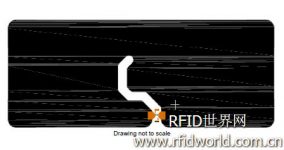
New label helps Metro achieve RFID application goals
[ad_1]
Metro Group has used RFID tags to track part of the pallets shipped to its supermarkets and wholesale food stores in the past two years. The company has now fully adopted this system in all food markets under Germany and at least 89 French stores. The retailer claims that the newly adopted Avery Dennison AD-843 UHF tags work more efficiently. The AD-843 label inlay is specially developed for Metro applications and performs first-class in liquid or metal environments.

AD-843 tags
Metro first adopted the AD-843 in January 2009. So far, Gerd Wolfram, the management director of Metro’s IT service department MGI, said that the new label has achieved a read rate of almost 100%, even if the labeling pallet is loaded with metal and Liquid goods.
Two years ago, Metro began to stick UHF Gen 2 tags on pallets, using readers and tags from multiple manufacturers. “Since 2007, we have noticed that the quality of Gen 2 labels has continued to improve,” Wolfram said. Now, Metro can basically achieve a 100% read rate of labelled pallets.
The supplier delivers pallets with food and other containers to Metro’s 9 distribution centers in Germany. These pallets are stored in the distribution center until they are reloaded with new pallets and shipped to the Metro Cash & Carry wholesale store and Real supermarket. Usually, when the distribution center receives an order from the store, the employee selects the required container, puts it on the mixed pallet and sends it to the store. The mixed pallet is affixed with an AD-843 label containing a unique ID code.
When the pallet is loaded onto the truck, a Sirit or Intermec RFID reader reads the ID code of the tag-even if the tag is blocked by other boxes-and sends these ID codes, together with the date and time, to the running software of the Metro server. The software is designed and integrated by MGI and includes the data of a pallet RFID tag ID code, which corresponds to the barcode serial number of the products loaded on these pallets, so that the software can translate the RFID data and track when the pallet is shipped.
When the pallet is shipped to one of the company’s retail stores (400 in total)-whether it is a Cash & Carry store in Germany and France, or a Real supermarket in Germany-the Sirit, Impinj or Intermec RFID readers installed in the receiving area read again Take the ID code of each pallet label. The software then updates to display the retailer who received the pallet.
In 2008, Metro tagged and tracked approximately 3 million pallets shipped from distribution centers to stores in Germany and France. However, this system still has some minor problems. Although the tags performed well, Wolfram said, their reading rate did not meet Metro’s expectations, and most of the liquid and metal products on the pallet affected the reading of UHF tags.
A year ago, Metro tried Avery Dennison’s AD-840 tag. The tag is 3.8 inches long and 1.6 inches wide. It contains an NXP G2XL chip and has an EPC memory of 240 bytes (512 bytes of additional user memory can also be selected). When Metro tested the AD-840 on a pallet containing metal or liquid products, it was found-this tag specifically designed for air parcel tracking applications-with satisfactory read rates, according to Maggie Bidlingmaier, head of global RFID sales and marketing at Avery Dennison say.
At Metro’s request, Avery Dennison agreed to develop a new label with higher performance. Among several design schemes provided by Avery Dennison, Metro chose the wide label AD-843. AD-843 is 3.8 inches wide and 1.6 inches long, contains Impinj Monza 3 chip, has 96 bytes of memory, and has a larger antenna than AD-840.
AD-843 can be applied to a variety of products and has powerful functions. It exhibits first-class working performance in liquid and metal environments, and has excellent readability in other common goods applications. Although AD-843 is specifically designed for Metro applications, it can also be used in many other applications.
According to Wolfram, Metro hopes to further extend RFID applications to the upper end of the supply chain. “We first label the pallets, and then label the containers. The specific time has not yet been determined. Part of this depends on the interest of our suppliers.”
Technical parameters of AD-843 tags (http://www.rfid.averydennison.com/_media/us/pdf/datasheets/AD843.pdf)
[ad_2]






